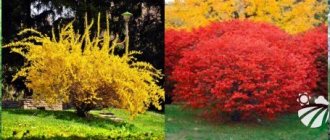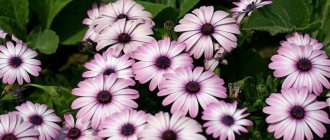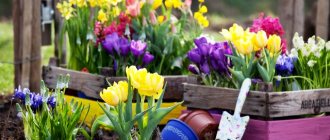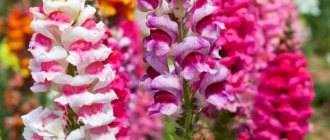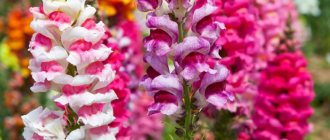Perennial garden flowers, as a rule, do not bloom for long. Perhaps this is the only drawback. However, this rule does not apply to everyone. There are a number of perennials that bloom beautifully all summer, and at the same time they are very attractive and unpretentious. By planting such plants in our garden, we get a double advantage: not only will we not need to grow seedlings every year (as is the case with annuals), but they will also delight you for a long time.
Flowering perennials: hollyhocks
Tall mallow, or hollyhock, is grown in a two-year cycle. In the first year, bushes with small rounded leaves grow from the seeds. In the next season, a powerful peduncle appears, which stretches up to 2 m.
Mallow: Unsplash
In appearance, mallows differ:
- long stem;
- variety of colors;
- simple or double flowering;
- large petals from 3 to 15 cm.
The mallow blooms from mid-July to early September. The perennial is unpretentious in care and takes root in any soil. In hot, dry weather, watering is carried out once a week. The perennial propagates by seeds and by dividing the bush.
Advice for a summer resident
The main requirement for flower beds with perennials is continuous flowering throughout the entire dacha period. This can be achieved only by studying the characteristics of the species you like and placing them harmoniously - according to height, color, shape, flower configuration, and flowering calendar.
Laying out a flower garden is a troublesome task for a novice gardener, but it is also a creative and exciting process. Only by following all the rules for arranging a dacha can you turn it into a favorite vacation spot for family and friends.
Delphinium
Perennial flowers that bloom all summer often shoot out their flower stalks only the following season. Such plants include delphinium from the buttercup family. In the first year, the flower strengthens the root system and expands the rosette, and a year later it pleases with bright flowering.
Delphinium: Pixabay
Growing rules:
- seeds for seedlings are sown in April;
- seedlings are planted in the ground in late May - early June;
- choose a windless area in partial shade with loose loamy soil;
- For propagation, seeds are sown into seedlings or the bush is divided into parts.
In May–July, the plant produces a pyramidal inflorescence, covered on all sides with flowers with spurs of white, blue and other pastel shades. The flowering bush grows from 40 cm to 2 m. If the flower stalks are cut, the plant will bloom again in the fall.
Echinacea
Echinacea, a member of the Asteraceae family, is a flower that blooms all summer. The plant pleases gardeners with its appearance and unpretentiousness, and also brings health benefits.
Echinacea: Pixabay
Features of Echinacea:
- throws out color in the second year after planting (early July - September);
- propagated by seeds and by separating young seedlings from the mother bush;
- grows in sunny areas;
- considered a medicinal plant.
In the second year after planting, long stems (up to 1 m) grow from the rosettes. Baskets open on erect peduncles. Reed flowers up to 15 cm in diameter have a purple-pink color. Brown tubular flowers are collected in the center of the basket. Cut echinacea does not fade for a long time.
Thrift
This perennial has flower colors ranging from pale pink to purplish red. Under favorable conditions, they appear periodically from April to mid-autumn. The basal rosette, up to 30 cm high, consists of long narrow leaves and thin peduncles and forms a beautiful decorative bush, and when overgrown, a lush cushion.
Yarrow
Among the perennial herbaceous plants of the Asteraceae family, decorative yarrow, or Achillea, is popular. These perennials, blooming in summer, quickly turn into original ikebana after cutting. The strong stems and inflorescences of Achillea dry out without losing their shape.
Yarrow: Pixabay
Growing technology:
- grows on any soil;
- practically does not require watering and additional fertilizing;
- prefers sunny areas;
- For propagation, seeds are sown, cuttings are taken or the mother bush is divided.
The basket of a blooming Achillea consists of reed and tubular flowers, but there are also single-flowered specimens (for example, the ageratoleaf species). The inflorescences are yellow, pink, white, etc.
climbing rose
What blooms for a long time in July? A climbing rose that will be an ideal decoration for a flower bed and adjoining area. With proper care, the perennial plant produces shoots from 6 to 15 m. Hybrid varieties bloom in summer and autumn.
Climbing Rose: Unsplash
Growing rules:
- select zoned varieties;
- plant seedlings in a sunny area in autumn or spring;
- During the growing season, water abundantly;
- Apply fertilizing in early spring;
- cover for the winter.
The flowers on climbing roses are double and small in size. The inflorescences contain several buds. They completely cover the stems, creating a bright background. Rose petals come in different colors - from white to dark burgundy. There are two-color varieties.
Clematis
Clematis (clematis) is valued by gardeners for its exquisite flowers and twining stems. Climbing perennials, blooming all summer, complement landscape design and help hide architectural flaws.
Clematis: Pixabay
Clematis have a number of advantages:
- liana-like stems, but there are also shrubs and subshrubs;
- fast-growing shoots from old stems or from rhizomes;
- simple and double flowers, collected in inflorescences or arranged one at a time;
- color palette from white to velvet blue.
The perennial blooms from June to late summer. For propagation, seedlings are grown from seeds. Rooted annual seedlings are placed in sunny areas in autumn or spring.
Clematis is suitable for nutritious soil with a good drainage layer. The plant does not tolerate excess moisture well, so water the flower only in dry weather.
Long-flowering low-growing perennials
If you need plants that do not require so much labor and resources to be invested in each year and that remain in the ground for several years, you should choose perennial species with a long flowering period - from spring to autumn. Low-growing perennials that bloom all summer are a fantastic, colorful decoration, thanks to them our gardens can be colorful not only in spring, but also in summer and autumn.
To decide which low-growing flowers to plant in the flowerbed, let's consider the most common types.
Phlox subulate
Phlox subulata is a perennial plant belonging to the Polemoniaceae family. It is found naturally in North America and is cultivated as an ornamental plant in many regions of the world. Belongs to a group of 5 main spring perennials planted in rock gardens.
Subulate Phlox is a turf plant with a creeping form, forming low (up to 10 cm in height) thick carpets. The stems are thin, densely branched, lanceolate leaves are located opposite each other. Phlox blooms profusely. The inflorescences are small, shiny, white, pink or purple.
Phlox is undemanding and easy to grow. Primary requirements:
- sunny position, but can grow in partial shade;
- The optimal soil is sandy and permeable, and can be successfully grown on most types of garden substrates.
Perennial phlox should be planted every 20-30 cm.
Alyssum
Low, creeping perennial, with yellow inflorescences. Plant height: 5-20 cm. Alyssum covers the surface with numerous rosettes of gray leaves. The leaves are rosette-gray, elongated, blade-shaped, covered with star-shaped hairs. Small, yellow, fragrant, flowers are collected in dense clusters that are short at first and elongated after flowering.
Suitable for sunny positions and weak soils, humus-clay or sandy, containing calcium. Alyssum is used in large rock gardens and rock gardens. Planted in small groups of 3-10 plants.
Coreopsis lanceolate
Coreopsis (Coreopsis lanceolata) - creates loose shoots, 40 cm long. This is a perennial plant with large yellow flowers with a brown accent at the base of the petals. Flowering occurs repeatedly from May to October. This is a plant with very few requirements.
Blood red geranium
Geranium sanguineum is a perennial herbaceous plant that blooms from May to September. The following varieties are interesting:
- The variety “Max Frei” deserves recognition - it creates dense clusters of flowers. During flowering, numerous small purple-pink inflorescences appear among the leaves.
- Another interesting variety is “Elke” - a perennial plant with beautiful, intense pink flowers with cream-colored petals. Geranium blooms for a long time.
Heuchera
Heuchera (Heuchera sanguinea) is a perennial border flower, including low-growing and dwarf varieties.
For example, the miniature variety "Can Can", the variety "Sweet Tart" - long-blooming with golden leaves that retain beautiful color throughout the season. It blooms from May to October, producing intense pink flowers.
Sunflower (stone flower)
Helianthemum hybridum - tender, or sunflower, helianthemum - rock shrub, one of the most flowering garden plants for rocky gardens. Notable flowering varieties are from May to September:
- Orange Pheonix - with beautiful orange flowers;
- Cerise Queen is a variety characterized by double flowers of purple-red color;
- The Bride - produces beautiful white flowers with a characteristic lemon scent;
- Ben Hope - bright pink flowers with yellow stamens.
Catnip
An herbaceous perennial with a characteristic lovely lemon scent that attracts butterflies, insects and cats. Catnip are low-growing perennial flowers that bloom all summer - from May to September, delighting with beautiful blue-violet inflorescences. Catnip creates small bushes 0.5 meters high.
Armeria seaside
These perennials belong to the lead family (Plumbaginaceae). They grow wild on the coasts of the northern regions of Europe. This low-growing evergreen plant reaches 15-25 cm, forming clusters of narrow herbaceous leaves. Armeria spreads by rhizomes, gradually forming a thick carpet.
Small purple-pink flowers are collected in inflorescences and grow on low peduncles 20 cm long. Flowering lasts from May to September (in favorable weather - until October), the main intensity of flowering occurs in June. After 3-4 years, the bush blooms more and more slowly and gradually dies.
Coastal armeria grows best on light, dry soils in sunny places. When flowering weakens, the bushes need to be rejuvenated - dug up, dead parts removed and planted in a new place. Armeria grows well in windy places and tolerates drought.
This low-growing, unpretentious and persistent plant is ideal for rock gardens, planting flower walls, decorating borders, edges, and planting on slopes.
Serpentine (highlander) related
Serpentine (Persicaria affine) is a perennial with abundant and long-lasting flowering. The plant produces beautiful spike-shaped flowers on long stems. The inflorescences in the buds have an intense red color and pinkish bloom, which gives a fantastic effect. The serpentine blooms from July to October.
Common yarrow (Ptarmika)
Yarrow (Achillea ptarmica) blooms in June-July. After this period, the inflorescences should be cut off in order to enjoy repeated intensive flowering in the event of a warm autumn. The lush white inflorescences of yarrow look charming and subtle against the background of the bushes. The perennial grows well in fertile, moist soil, in sun and partial shade.
Narrow-leaved lavender
Garden lavender (Lavandula angustifolia) is an ideal perennial plant for long-lasting flowering in the garden. Perennial shrub with a compact form. The flowers are fragrant blue-violet, honey-bearing, appear from June to October. The evergreen, narrow leaves are covered with a coating that gives them a silvery tint. Lavender has few requirements and is easy to grow.
Dianthus grass
Carnations are known and loved for their abundant and long-lasting flowering. A very rewarding perennial with universal use and very little soil requirements. The bush is always full of flowers with a pleasant aroma. The perennial comes in numerous cultivars with a diverse range of colors. Flowering lasts a long time - from June to September. Recommended for compositions for ridges, rock gardens, borders and containers.
Bell
Bluebells (Campanula) are easy to grow, but their requirements depend on the species, and there are about 200 of them. Campanulas need sun and a not very fertile substrate, preferably permeable with a neutral or slightly alkaline reaction. There are tall and short varieties. The ornamental plant is used for ridges, rocky gardens, and as a border plant.
Campanula glomerata is a dwarf variety of bellflower, reaching a height of 25 cm with dark purple inflorescences on stiff shoots. The plant does not like stagnant water. Flowering begins in June and continues until the end of August. The Nana Alba variety with white flowers looks attractive.
Evening primrose or aspen
Evening primrose has more than 120 species, mostly from North America, which have become partially naturalized in various regions of the world. A common feature is flowers consisting of 4 large petals, usually yellow, less often white, pink, purple. Oslinnik loves dry, sunny places, preferring mineral and permeable substrates. Perennials work well in naturalistic and prairie gardens to create large, dense splashes of yellow. Oenothera missouriensis is characterized by an extremely large flower and works well in rock gardens and along the edges of perennial beds.
Fuopsis
A lush perennial plant with an intense aroma. These perennial flowers grow up to 20-30 cm tall. Fuopsis grows quickly, covering the substrate with a carpet of thin green shoots with ascending flowering stems. Creates a thick, fragrant carpet in the garden. The leaves and stems of the plant contain coumarin, which gives a musky aroma, especially intense after rain.
The small, sweet-spicy flowers are shaped like tubular, pink funnels. Flowering lasts from June to August, spherical inflorescences appear on the tops of the shoots. A characteristic feature is the long, convex necks of the pistil.
As a vigorous growing plant, Fuopsis is great for covering large areas. A suitable place for growing perennials is rock gardens and dry walls, which quickly become covered with green shoots and then pink flowers. Planted as a low perennial plant on slopes, where it will prevent the development of weeds and protect the soil from erosion. The plant is resistant to frost and pests.
Phloxes
Unpretentious phloxes have a delicate aroma. They decorate the garden with spherical inflorescences. These perennials are placed in the center of the flower bed or near the fence. The main thing is that the landing site is illuminated by the sun throughout the day.
Phlox: Pixabay
Breeders have already bred about 1.5 thousand varieties of phlox, which differ in:
- colors (white, crimson, red, lilac, etc.);
- size of inflorescences (up to 90 flowers);
- bush height (from 5 to 180 cm);
- flower diameter (2.5–4 cm).
For summer flowering, paniculate phlox are planted. They are in bloom from June to August. You can plant phlox by sowing seeds, but it is better to plant mother bushes to speed up flowering.
Shade-loving perennials - description of popular species
In any garden with trees there are areas that are in the shade most of the day. There is a category of flowers that live well in such conditions. This is a series of herbaceous plants with decorative foliage, as well as shade-tolerant flowers for the garden, developing over several years. Their main purpose is to fill empty spaces and prevent weeds from appearing.
Periwinkle is a unique perennial plant with a rich history.
Ideal plantings would be periwinkle, lungwort, Siberian bunnera, shieldweed, and May lily of the valley. There is a selection of accent plants with decorative foliage and beautiful flowering: astilbe, black cohosh, Japanese anemoma, Rogersia, elecampane.
In early spring, delicate primroses appear: snowdrops, scillas, jeffersonia, and anemone. The yellow carpet of celandine is usually alternated with fern. In the summer, martagon, lilies, sinuous corydalis, and dotted bells bloom.
Lily is an amazingly beautiful flower with a pleasant aroma that has been revered in many cultures.
Shade-loving perennials do not like the autumn cold, so only some plants bloom buds - kirengeshoma palmate with beautiful large decorative leaves and bell-shaped flowers.
A special role in the creation of flower beds belongs to the hosta and the shield plant. They decorate the flowerbed with decorative foliage: the unique waffle texture and the scaly texture of the feathery leaves. You can plant tulips, daffodils, and hyacinths as bright accents. Tulips are beautiful in a duet with delicate and sophisticated blue forget-me-nots.
Tulips feel great in one place for 5-6 years, growing into charming, picturesque curtains.
Red fescue is perfect for grass cover. It tolerates a lack of sunlight well, is ideal for creating a lawn, grows quickly, and is unpretentious.
The most popular types:
- Astilbe - very spectacular bright pink inflorescences. It is unpretentious, loves water very much, lives for about 5 years, after which the bush is replanted. Rhizomes are planted in early May. Loves shade and partial shade, loose soil;
- Primrose is a primrose, distinguished by its variety of colors and unpretentious character. Pleasant aroma and abundant flowering, forming a bright picturesque carpet. Rhizomes are planted in early May. Loves partial shade and moist, nutritious soil.
Primroses are very beautiful, charming spring flowers that are popular among many gardening enthusiasts.
Creating compositions for a shady garden is a real art that requires knowledge and patience, but the result will exceed all expectations.
It is recommended to plant plants of 8-10 different species and with different flowering periods.
Lily
Bulbous perennials are common in the garden. Lily is their bright representative.
Lily: Unsplash
Features of perennial:
- a varied palette of shades - white, red, soft pink, orange, purple lilies;
- flower shape with smooth and corrugated petals;
- unusual aroma;
- multi-flowered inflorescences (16–30 flowers);
- stem height - 0.5–2.5 m.
During the season, 10–15 inflorescences open on thick stems. This significantly extends the flowering time of lilies from June to mid-autumn.
The flower propagates by bulbs, which are planted in spring or autumn in prepared holes with nutritious soil mixture. For planting lilies, select a semi-shaded area. For lush flowering, follow the watering regime.
Erigeron
The polypetaled plant (erigeron) forms a low basal rosette, from which sparsely leafed peduncles up to 80 cm high rise. Several double flowers of pink or lilac shades are formed on each shoot. It blooms twice a season (in June and August), creating lush and very attractive clumps.
Erigeron is unpretentious, content with minimal care: watering during dry periods, fertilizing with rotted compost during budding. It is used to create flower borders and is planted in mixed flower beds and mixborders. It can act as both a leading and auxiliary plant.
Low-growing perennial flowers: alyssums
Marine alyssum, or alyssum, is a perennial plant that is resilient and unpretentious. Alyssum bushes rise above the ground up to 20 cm. The stems quickly grow to the sides and cover the soil with a flowering carpet.
Alyssum marine: YouTube/Floristics Info
Small white or pink flowers completely cover the stems, creating the effect of an airy cloud in the flowerbed. Alyssum is planted:
- in separate groups on the lawns;
- along borders and garden paths;
- on the alpine slides;
- on the first line of flower beds.
Alyssum blooms from late May until late autumn, emitting a delicate aroma. The smell of flowers attracts bees and other insects to the garden.
Alyssum grows best in loose, neutral soil. The site can be chosen in the sun or in partial shade. Plants are watered and fertilized according to a schedule, accelerating the process of growing and flowering.
Autumn unpretentious perennials
It is important to maintain the beauty of the garden in the autumn. For this purpose, it is good to cultivate perennial flowers for the garden, among which the most unpretentious crops can be distinguished.
Perennial asters
Aster perennial is a long-flowering herbaceous plant of the Asteraceae family. The genus includes more than 200 species, which are widely distributed as unpretentious ornamental plants.
Aster, as a rhizomatous, long-flowering perennial, forms branching shoots with small leaves. Its root system grows in width, occupying more and more space over time. Depending on their height, asters are divided into low-growing (15 - 20 cm), medium (30 - 60 cm) and tall (more than 70 cm). The inflorescences have the shape of baskets with a variety of color options.
Important! Low-growing, long-flowering asters will complement group plantings well on the lawn, alpine hill and flat rock garden. Medium and tall forms are used in mixborders.
Phlox
Phlox is a long-flowering perennial of the Cynuaceae family, which includes more than 60 species of plants. Under natural conditions, the culture is widespread throughout North America.
The plant can have erect or creeping stems, the length of which varies from 10 to 150 cm. It is a perennial with sessile leaves located opposite the bottom of the stem. The leaf shape is oval-lanceolate or lanceolate.
Phlox bloom for a long time, their flowers with an eye in the center form paniculate or corymbose inflorescences, different in size and structure. Depending on the variety, their color can be white, lilac-blue, pink or red. The flowering period falls in May.
Due to its decorative properties and unpretentious nature, long-flowering phlox is actively used in landscape design: ground cover varieties for decorating rocky hills, tall forms for group plantings.

